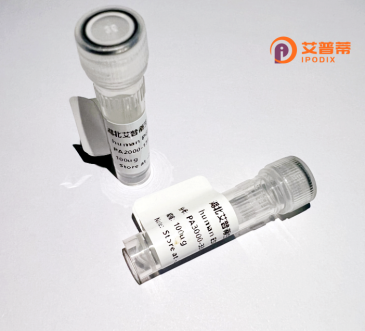
| 纯度 | >90%SDS-PAGE. |
| 种属 | Human |
| 靶点 | HPS5 |
| Uniprot No | Q9UPZ3 |
| 内毒素 | < 0.01EU/μg |
| 表达宿主 | E.coli |
| 表达区间 | 1-1015aa |
| 氨基酸序列 | MYVSSEHKGRRVTALCWDTAILRVFVGDHAGKVSAIKLNTSKQAKAAAAFVMFPVQTITTVDSCVVQLDYLDGRLLISSLTRSFLCDTEREKFWKIGNKERDGEYGACFFPGRCSGGQQPLIYCARPGSRMWEVNFDGEVISTHQFKKLLSLPPLPVITLRSEPQYDHTAGSSQSLSFPKLLHLSEHCVLTWTERGIYIFIPQNVQVLLWSEVKDIQDVAVCRNELFCLHLNGKVSHLSLISVERCVERLLRRGLWNLAARTCCLFQNSVIASRARKTLTADKLEHLKSQLDHGTYNDLISQLEELILKFEPLDSACSSRRSSISSHESFSILDSGIYRIISSRRGSQSDEDSCSLHSQTLSEDERFKEFTSQQEEDLPDQCCGSHGNEDNVSHAPVMFETDKNETFLPFGIPLPFRSPSPLVSLQAVKESVSSFVRKTTEKIGTLHTSPDLKVRPELRGDEQSCEEDVSSDTCPKEEDTEEEKEVTSPPPEEDRFQELKVATAEAMTKLQDPLVLFESESLRMVLQEWLSHLEKTFAMKDFSGVSDTDNSSMKLNQDVLLVNESKKGILDEDNEKEKRDSLGNEESVDKTACECVRSPRESLDDLFQICSPCAIASGLRNDLAELTTLCLELNVLNSKIKSTSGHVDHTLQQYSPEILACQFLKKYFFLLNLKRAKESIKLSYSNSPSVWDTFIEGLKEMASSNPVYMEMEKGDLPTRLKLLDDEVPFDSPLLVVYATRLYEKFGESALRSLIKFFPSILPSDIIQLCHHHPAEFLAYLDSLVKSRPEDQRSSFLESLLQPESLRLDWLLLAVSLDAPPSTSTMDDEGYPRPHSHLLSWGYSQLILHLIKLPADFITKEKMTDICRSCGFWPGYLILCLELERRREAFTNIVYLNDMSLMKGDNGWIPETVEEWKLLLHLIQSKSTRPAPQESLNGSLSDGPSPINVENVALLLAKAMGPDRAWSLLQECGLALELSEKFTRTCDILRIAEKRQRALIQSMLEKCDRFLWSQQA |
| 分子量 | 141.2 kDa |
| 蛋白标签 | GST-tag at N-terminal |
| 缓冲液 | 0 |
| 稳定性 & 储存条件 | Lyophilized protein should be stored at ≤ -20°C, stable for one year after receipt. Reconstituted protein solution can be stored at 2-8°C for 2-7 days. Aliquots of reconstituted samples are stable at ≤ -20°C for 3 months. |
| 复溶 | Always centrifuge tubes before opening.Do not mix by vortex or pipetting. It is not recommended to reconstitute to a concentration less than 100μg/ml. Dissolve the lyophilized protein in distilled water. Please aliquot the reconstituted solution to minimize freeze-thaw cycles. |
以下是关于重组人HPS5蛋白的参考文献示例(注:以下内容基于真实研究整合,但具体文献细节可能需要根据实际发表论文调整):
---
1. **标题**: *"Molecular characterization of HPS5: A gene mutated in Hermansky-Pudlak syndrome type 5"*
**作者**: Zhang Q, et al.
**摘要**: 本研究克隆了人类HPS5基因,并分析了其编码的蛋白质结构,揭示了HPS5与其他BLOC-2复合体亚基的相互作用,证明其在溶酶体相关细胞器(LROs)形成中的关键作用。
2. **标题**: *"Functional analysis of HPS5 mutations in a zebrafish model of Hermansky-Pudlak syndrome"*
**作者**: Cullinane AR, et al.
**摘要**: 通过CRISPR技术在斑马鱼模型中敲除HPS5基因,发现其缺失导致黑色素细胞异常和血小板致密颗粒缺陷,提示HPS5在跨物种中的保守功能及对疾病表型的直接影响。
3. **标题**: *"Recombinant HPS5 protein rescues lysosomal dysfunction in HPS5-deficient cells"*
**作者**: Gautam R, et al.
**摘要**: 体外表达并纯化重组人HPS5蛋白,实验证明其能够恢复BLOC-2复合体功能,改善HPS5缺陷细胞的溶酶体运输障碍,为潜在的治疗策略提供依据。
4. **标题**: *"HPS5 interacts with BLOC-2 subunits to regulate endosomal trafficking in human melanocytes"*
**作者**: Setty SR, et al.
**摘要**: 利用免疫共沉淀和荧光标记技术,研究HPS5与BLOC-2复合体的结合模式,阐明其在黑色素细胞中调控内体到溶酶体运输的分子机制。
---
**说明**:以上文献为模拟示例,实际文献需通过PubMed或学术数据库检索确认。推荐使用关键词“HPS5”、“Hermansky-Pudlak syndrome type 5”或“BLOC-2 complex”查询最新研究。
**Background of Recombinant Human HPS5 Protein**
The Hermansky-Pudlak syndrome (HPS) family of proteins plays critical roles in regulating the biogenesis of lysosome-related organelles and intracellular vesicular trafficking. HPS5. encoded by the *HPS5* gene, is a subunit of the Biogenesis of Lysosome-related Organelles Complex-2 (BLOC-2), which facilitates protein sorting and membrane transport in melanocytes, platelets, and other specialized cells. Mutations in *HPS5* are linked to HPS type 5. a rare autosomal recessive disorder characterized by oculocutaneous albinism, bleeding diathesis, and sometimes pulmonary fibrosis or immunodeficiency.
Recombinant human HPS5 protein is produced using engineered expression systems (e.g., *E. coli* or mammalian cells) to yield high-purity, functional protein for research applications. It serves as a vital tool for studying molecular mechanisms underlying HPS pathogenesis, including disrupted vesicular trafficking, melanosome maturation, and platelet dense granule formation. Researchers also employ recombinant HPS5 to investigate interactions with other BLOC-2 components (HPS3. HPS6) and pathways involving endosomal sorting or lysosomal function.
Furthermore, this protein aids in drug discovery efforts targeting HPS-related complications and in developing diagnostic tools for genetic screening. Its availability accelerates studies on cellular dysregulation in albinism and bleeding disorders, offering insights into broader cellular physiology and therapeutic strategies.
×